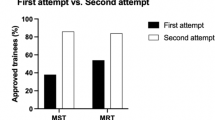Abstract
Background
INtraoperative Video Enhanced Surgical procedure Training (INVEST) is a new training method designed to improve the transition from basic skills training in a skills lab to procedural training in the operating theater. Traditionally, the master–apprentice model (MAM) is used for procedural training in the operating theater, but this model lacks uniformity and efficiency at the beginning of the learning curve. This study was designed to investigate the effectiveness and efficiency of INVEST compared to MAM.
Methods
Ten surgical residents with no laparoscopic experience were recruited for a laparoscopic cholecystectomy training curriculum either by the MAM or with INVEST. After a uniform course in basic laparoscopic skills, each trainee performed six cholecystectomies that were digitally recorded. For 14 steps of the procedure, an observer who was blinded for the type of training determined whether the step was performed entirely by the trainee (2 points), partially by the trainee (1 point), or by the supervisor (0 points). Time measurements revealed the total procedure time and the amount of effective procedure time during which the trainee acted as the operating surgeon. Results were compared between both groups.
Results
Trainees in the INVEST group were awarded statistically significant more points (115.8 vs. 70.2; p < 0.001) and performed more steps without the interference of the supervisor (46.6 vs. 18.8; p < 0.001). Total procedure time was not lengthened by INVEST, and the part performed by trainees was significantly larger (69.9 vs. 54.1 %; p = 0.004).
Conclusions
INVEST enhances effectiveness and training efficiency for procedural training inside the operating theater without compromising operating theater time efficiency.

Similar content being viewed by others
References
Berguer R, Forkey DL, Smith WD (1999) Ergonomic problems associated with laparoscopic surgery. Surg Endosc 13:466–468
Van Det MJ, Meijerink WJ, Hoff C, Totte ER, Pierie JP (2009) Optimal ergonomics for laparoscopic surgery in minimally invasive surgery suites: a review and guidelines. Surg Endosc 23:1279–1285
Gallagher AG, McClure N, McGuigan J, Ritchie K, Sheehy NP (1998) An ergonomic analysis of the fulcrum effect in the acquisition of endoscopic skills. Endoscopy 30:617–620
Van Det MJ, Meijerink WJ, Hoff C, Van Veelen MA, Pierie JP (2008) Ergonomic assessment of neck posture in the minimally invasive surgery suite during laparoscopic cholecystectomy. Surg Endosc 22:2421–2427
Aggarwal R, Darzi A (2006) Technical-skills training in the 21st century. N Engl J Med 355:2695–2696
Furnee EJ, van Empel PJ, Mahdavian Delavary B, van der Peet DL, Cuesta MA, Meijerink WJ (2009) Evaluation of a technical skills training program in surgical residents. J Laparoendosc Adv Surg Tech A 19:615–621
Okrainec A, Soper NJ, Swanstrom LL, Fried GM (2011) Trends and results of the first 5 years of fundamentals of laparoscopic surgery (FLS) certification testing. Surg Endosc 25:1192–1198
Gurusamy KS, Aggarwal R, Palanivelu L, Davidson BR (2009) Virtual reality training for surgical trainees in laparoscopic surgery. Cochrane Database Syst Rev (1):CD006575
Larsen CR, Soerensen JL, Grantcharov TP, Dalsgaard T, Schouenborg L, Ottosen C, Schroeder TV, Ottesen BS (2009) Effect of virtual reality training on laparoscopic surgery: randomized controlled trial. BMJ 338:b1802
Panait L, Akkary E, Bell RL, Roberts KE, Dudrick SJ, Duffy AJ (2009) The role of haptic feedback in laparoscopic simulation training. J Surg Res 156:312–316
Botden SM, Torab F, Buzink SN, Jakimowicz JJ (2008) The importance of haptic feedback in laparoscopic suturing training and the additive value of virtual reality simulation. Surg Endosc 22:1214–1222
Van Det MJ, Meijerink WJ, Hoff C, Middel LJ, Koopal SA, Pierie JP (2011) The learning effect of intra operative video enhanced surgical procedure training. Surg Endosc 25:2261–2267
Martin JA, Regehr G, Reznick R, MacRae H, Murnaghan J, Hutchison C, Brown M (1997) Objective structured assessment of technical skill (OSATS) for surgical residents. Br J Surg 84:273–278
Verdaasdonk EG, Stassen LP, Schijven MP, Dankelman J (2007) Construct validity and assessment of the learning curve for the SIMENDO endoscopic simulator. Surg Endosc 21:1406–1412
Verdaasdonk EG, Dankelman J, Lange JF, Stassen LP (2008) Incorporation of proficiency criteria for basic laparoscopic skills training: how does it work? Surg Endosc 22:2609–2615
Guideline Galsteenziekte (2007) Appendix D: “Best practice” laparoscopische cholecystectomie. Dutch Soc Surg. http://www.heelkunde.nl/kwaliteit/richtlijnen/richtlijnen-definitief. Accessed Nov 2009
Strasberg SM (2002) Avoidance of biliary injury during laparoscopic cholecystectomy. J Hepatobiliary Pancreat 9:543–547
Cohen J (1988) The t test for means. In: Statistical power analysis for the behavioural sciences. Lawrence Erlbaum Associates, Hillsdale, NJ, pp 19–74
Acknowledgments
The authors thank J. M. P. Collins for reviewing the text. They also thank the supervising surgeons and participating residents for their contribution.
Disclosures
Drs. M. J. van Det, W. J. H. J. Meijerink, C. Hoff, B. Middel, and J. P. E. N. Pierie have no conflicts of interest or financial ties to disclose.
Author information
Authors and Affiliations
Corresponding author
Rights and permissions
About this article
Cite this article
van Det, M.J., Meijerink, W.J.H.J., Hoff, C. et al. Effective and efficient learning in the operating theater with intraoperative video-enhanced surgical procedure training. Surg Endosc 27, 2947–2954 (2013). https://doi.org/10.1007/s00464-013-2862-2
Received:
Accepted:
Published:
Issue Date:
DOI: https://doi.org/10.1007/s00464-013-2862-2




